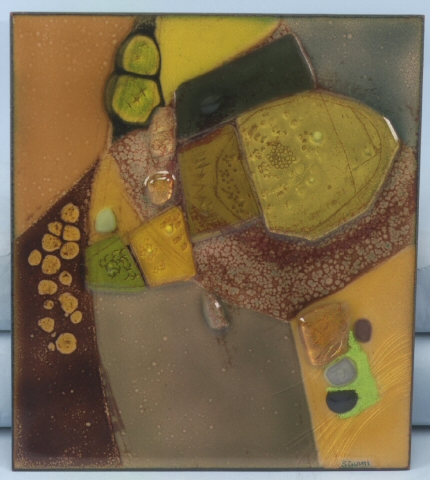Dorothy Sturm

(1910-1988) born and lived in Memphis
Enamel and Glass on Copper, 1970
enamel, glass, and copper, 9.125 x 8.125 x .75 inches, 70.36.30
When Sturm turned 19, she left Memphis and moved to New York City where she studied at the Grand Central School of Art, the Art Students League, and Columbia University. While she lived in New York, Sturm developed an interest in biology that led her to a career as a medical illustrator.
Sturm moved back home in 1934, and the next year she became a founding faculty member at the Memphis Academy of Art, now Memphis College of Art. In her early career, Strum focused on creating collages, drawings, and mixed media paintings on paper, and she taught classes on the same subjects. To supplement her teaching and illustrator income, she also began working for the Binswanger Glass Company in the mid-1950s. At Binswanger, Sturm learned the basics of stained-glass construction, and it was also during this time that she began experimenting with enameling. In 1956 Sturm was the illustrator for the book The Morphology of Human Blood Cells. She also had an interest she followed for 20 years in enamel work in abstract expressionism design. In 1975, Sturm retired from Memphis Academy of Art as a Professor Emeritus.
Her work is featured in numerous collections including the American Embassy in Paris, the Smithsonian Institution, Archives of American Art in Washington, DC; the Arkansas Arts Center in Little Rock, AR; Arrowmont School of Arts and Crafts in Gatlinburg, TN; Charleston Museum in Charleston, WV; The Chicago Art Institute in Chicago, IL; the Jean DeMenil Collection in Paris, and the First Tennessee Heritage Collection, JR Hyde, III Collection, Memphis Brooks Museum of Art, and the National Ornamental Metal Museum all of which are in Memphis.

